Many people struggle with oily hair, which can detract from your overall appearance and confidence. Understanding the underlying causes of greasy hair is essential for effective management. In this article, we’ll explore the factors that contribute to oily hair, from hormonal fluctuations to hair type, and provide practical tips to help you maintain a fresh and healthy look. Read on to discover how to combat greasiness and keep your locks looking their best!
What Does Greasy Hair Look Like?
Greasy hair tends to look flat, dull, and shiny in a way that reflects light unnaturally, especially at the roots. It often feels sticky or slick to the touch, and the natural bounce of the hair can be lost. The oily appearance is most noticeable at the scalp, where sebum (the natural oil produced by the sebaceous glands) builds up.
How to Tell If Your Hair Is Greasy or Shiny
It can be hard to differentiate between natural shine and greasiness, but there are a few signs that indicate your hair might be greasy:
- Shiny, flat roots: If your hair has a greasy appearance near the roots but appears limp or weighed down, it's likely oily.
- Heavy texture: Greasy hair feels thick or sticky, while shiny hair typically feels light and airy.
- Clumping: If your hair feels like it’s sticking together or separating, it could be due to the buildup of oil.
How Long Does It Take for Hair to Get Greasy?
The speed at which your hair becomes greasy can depend on several factors, including hair type, scalp health, and how often you wash it. For some people, hair may start showing oil just hours after washing, while for others, it may take a day or two. Generally, for those with oil-prone scalps, hair can become greasy within 12 to 24 hours of washing.
Why Does My Hair Get Oily Fast?
Hair becomes greasy due to the production of sebum, which is the scalp’s natural oil. This oil is essential for keeping your hair moisturized and protected. However, an overproduction of sebum leads to greasy hair.
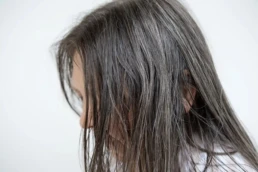
Greasy Hair After One Day
If your hair gets greasy just one day after washing, it could be due to:
- Hormonal fluctuations: Hormones can stimulate the sebaceous glands, leading to quicker oil production.
- Over-washing: Washing your hair too frequently strips your scalp of natural oils, causing it to compensate by producing more sebum.
- Environmental factors: Humidity and heat can cause your scalp to produce more oil.
Hair Greasy After Washing
It may seem counterintuitive, but some people experience greasy hair immediately after washing. This can happen when:
- Residual product buildup: If styling products weren’t completely rinsed out, they can combine with natural oils to give a greasy appearance.
- Improper washing technique: Using too much conditioner or not rinsing thoroughly can cause hair to feel greasy post-wash.
- Wrong shampoo: If your shampoo isn’t the right fit for your hair type, it can either over-dry your scalp or not cleanse effectively.
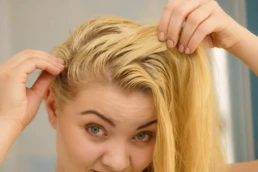
Why Is My Hair Getting Greasy So Quick?
If your hair is becoming greasy faster than usual, it could be due to:
- Diet: Foods high in fats, sugars, and dairy may increase oil production on your scalp.
- Stress: Elevated stress can lead to hormonal changes, triggering an increase in sebum production.
- Changes in weather: Hot and humid environments can cause sebaceous glands to work overtime.
Does Hair Type Affect Greasiness?
Yes, your hair type plays a significant role in how quickly it becomes greasy. Different textures and thicknesses of hair interact with sebum differently, influencing how oil is distributed and how quickly it accumulates.
Fine or thin hair tends to get greasy faster, as the oil has less surface area to spread, while thicker or coarser hair may take longer to show signs of greasiness but can feel weighed down if not properly cared for.
Greasy Curly Hair
Curly hair may appear greasy at the roots because sebum struggles to travel down the twists and turns of each strand. While the ends tend to be drier, the scalp can still produce excess oil, leading to greasy roots. Opt for lightweight, moisturizing products that hydrate without weighing down curls.
Thin Greasy Hair
Fine hair tends to get greasy faster because it has less surface area for oil to spread out. Even a small amount of sebum can cause thin hair to look greasy and flat. Use lightweight, clarifying shampoos to help manage oil buildup.
Does Long Hair Get Greasy Faster?
Long hair doesn’t necessarily get greasy faster, but it can be more noticeable. The oil has more hair to travel down, which can delay the appearance of greasiness. However, long hair can also accumulate more product residue at the scalp if not washed properly, contributing to a greasy appearance.
Does Short Hair Get Oily Faster?
Short hair can get oily faster because there’s less length to absorb the sebum. With shorter hair, the oil stays concentrated at the scalp, making it visible much quicker than with longer hair.
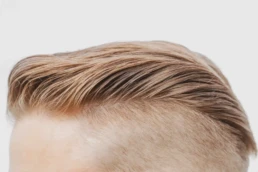
Managing Greasy Hair
Proper hair care plays a crucial role in keeping oily hair under control. While oil production is a natural part of scalp health, excessive oil can weigh down your hair and make it appear greasy. Here are some practical tips to help you extend the time between washes and maintain a fresh, clean look:
- Choose the Right Shampoo: Opt for a clarifying or lightweight shampoo designed for oily hair. Look for products that gently cleanse excess oil without stripping your scalp of its natural moisture. Avoid heavy, hydrating shampoos, as they can exacerbate oiliness.
- Wash Your Hair Strategically: While it might be tempting to wash your hair daily, overwashing can signal your scalp to produce even more oil. Instead, aim to wash your hair every other day or as needed, depending on how oily it gets. Focus on cleansing your scalp thoroughly, as this is where most of the oil accumulates.
- Use Conditioner Wisely: Avoid applying conditioner to your roots, as this can weigh down your hair and make it greasy. Instead, focus on the mid-lengths and ends, where your hair needs moisture the most. Opt for a lightweight, oil-free conditioner to prevent buildup.
- Incorporate Dry Shampoo: Dry shampoo is your best friend for managing oily hair between washes. It absorbs excess oil at the roots and adds volume, making your hair look fresher for longer. Apply it sparingly and work it in with your fingers for a natural finish.
- Avoid Touching Your Hair: Constantly running your fingers through your hair can transfer oils from your hands and stimulate your scalp, increasing oil production. Try to avoid unnecessary touching or brushing throughout the day.
- Use Lukewarm Water: Hot water can strip your scalp of natural oils, causing it to produce even more oil to compensate. Washing your hair with lukewarm water helps maintain balance and keeps your scalp healthy.
- Opt for Scalp Treatments: Consider professional treatments like the Express Scalp Renewal Treatment offered at Charm and Champagne Beauty Studio. Designed for oily scalps, this treatment reduces sebum, restores a clean surface, and refreshes your scalp, leaving your hair feeling light and clean.
- Watch Your Diet: Your diet can also impact oil production. Foods high in refined carbs, sugar, and greasy snacks can contribute to excess scalp oil. Opt for a balanced diet rich in fruits, vegetables, and lean proteins to support healthy hair from within.
By incorporating these tips into your routine and tailoring your hair care to your unique needs, you can keep your hair looking fresh and clean for longer while reducing excessive oiliness.
Does Washing Your Hair with Just Water Make It Greasy?
Washing your hair with just water doesn’t effectively cleanse it. While it may rinse off some oil, it doesn’t remove buildup or product residue. To keep your hair truly fresh, use a gentle, sulfate-free shampoo that’s suited for your hair type.
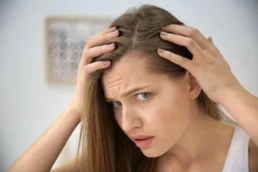
Does Touching Your Hair Make It Greasy?
Yes, frequently touching your hair can transfer oils from your hands to your strands, making them greasy faster. Try to avoid touching your hair throughout the day to keep it looking fresh.
Products for Greasy Hair
At Charm and Champagne Beauty Studio, we offer a curated selection of Aveda products designed to help manage oily hair effectively. Choosing the right hair care solutions tailored to your needs can make all the difference in keeping your locks fresh and balanced.
Shampoo for Greasy Scalp and Dry Hair
If you have a greasy scalp but dry hair, try Aveda’s Scalp Solutions Shampoo. It gently cleanses the scalp without stripping your hair of moisture, helping to balance oil production while keeping your strands hydrated.
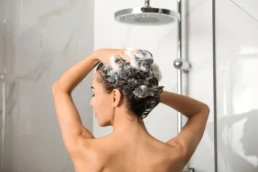
Conditioner for Greasy Hair
For oily hair, use a lightweight conditioner like Aveda’s Shampure Conditioner. It hydrates without weighing your hair down, preventing it from looking greasy or flat.
Dry Shampoo for Greasy Hair
Dry shampoo is a great tool for extending the time between washes. Aveda’s Shampowder Dry Shampoo is a great option, absorbing excess oil while leaving your hair smelling fresh and looking voluminous.
Men’s Shampoo for Greasy Hair
Men’s hair care also benefits from Aveda’s product range. Aveda Men’s Pure-Formance Shampoo is ideal for those with oily hair, as it cleanses the scalp thoroughly without leaving it feeling dry or stripped.
How to Prevent Greasy Hair
To prevent greasy hair, adopt a balanced hair care routine:
- Wash your hair regularly: Don’t over-wash, but aim to wash your hair every two to three days.
- Use the right products: Choose shampoos and conditioners formulated for oily hair.
- Avoid heavy styling products: Opt for lightweight styling products that won’t add extra grease.
- Keep your scalp healthy: Regular scalp massages and exfoliation help regulate oil production.
- Maintain a healthy diet: Include vitamins, minerals, and omega-3s to support a healthy scalp.
By understanding why your hair gets greasy quickly and adopting the right products and habits, you can keep your hair looking fresh, shiny, and healthy. With the right care, managing greasy hair becomes much more manageable.

